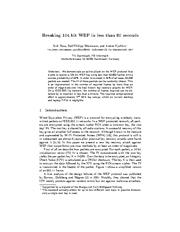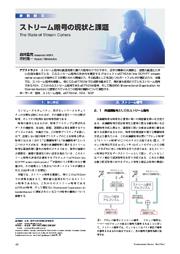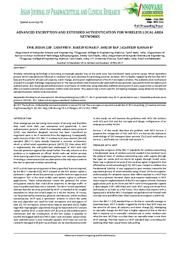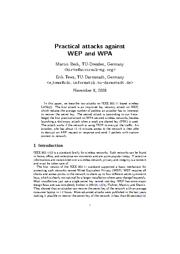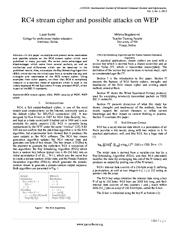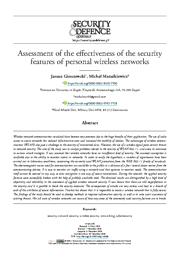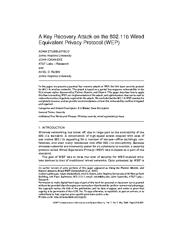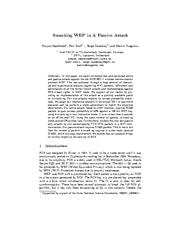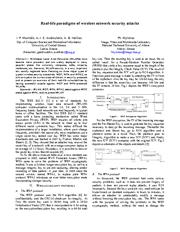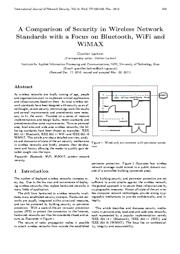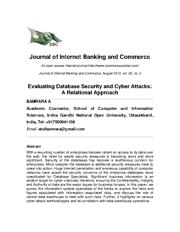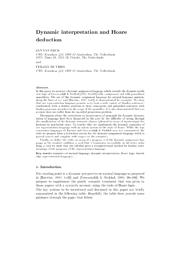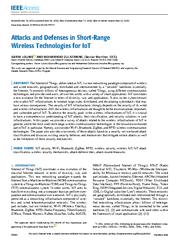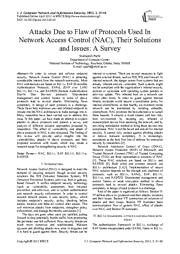A copy of this work was available on the public web and has been preserved in the Wayback Machine. The capture dates from 2013; you can also visit the original URL.
The file type is application/pdf.
Filters
Breaking 104 Bit WEP in Less Than 60 Seconds
[chapter]
2007
Lecture Notes in Computer Science
We demonstrate an active attack on the WEP protocol that is able to recover a 104-bit WEP key using less than 40,000 frames with a success probability of 50%. ...
On a IEEE 802.11g network, the number of frames required can be obtained by re-injection in less than a minute. ...
Breaking implementations using larger WEP keys Some vendors implemented WEP using root keys longer than 104 bit. We have seen implementations using up to 232 bit key length for the root key. ...
doi:10.1007/978-3-540-77535-5_14
fatcat:26tsb37axfgndijisanl4fmgru
The State of Stream Ciphers
2009
IEICE ESS FUNDAMENTALS REVIEW
Pyshkin, Breaking 104 bit WEP in less than 60 seconds, Cryptology ePrint, 2007, available at http://eprint.iacr.org/2007/120.pdf 21 A. ...
2007
Tews
IV
104
20
PTW
TPW
Tews
PTW
2006
Klein
21
PTW
ARP
ARP
WEP
WEPplus
WEP
ARP
IP
22
PTW
104
30,000 IP
20MB
104
10
WEP
WEP
WEP
WPA WPA2
,
LAN ...
doi:10.1587/essfr.2.3_66
fatcat:nrohgmqeaffhfaq4zvj5spepie
ADVANCED ENCRYPTION AND EXTENDED AUTHENTICATION FOR WIRELESS LAN
2017
Asian Journal of Pharmaceutical and Clinical Research
WEP standards are followed in WLANs for providing security. ...
But WEP is fatally crippled by the fact that WEP keys are the same for all users, all sessions and never changes and its poor implementation of the RC4 encryption scheme. ...
Feature
WEP
WPA
WPA2
Cipher
RC-4
RC-4
AES
Key length
40 or 104 bits
128 bits
encryption
64 bits
128 bits
IV size
24 bits
48 bits
48 bits
Per-frame key
Concatenated
Mixing
function ...
doi:10.22159/ajpcr.2017.v10s1.19987
fatcat:qshgcbfccvcvbnkzpqfjyqg3ce
Practical attacks against WEP and WPA
2009
Proceedings of the second ACM conference on Wireless network security - WiSec '09
In this paper, we describe two attacks on IEEE 802.11 based wireless LANs[2]. ...
The first attack is an improved key recovery attack on WEP, which reduces the average number of packets an attacker has to intercept to recover the secret key. ...
If more than 2 MIC verification failures occur in less than 60 seconds, the communication is shut down, and all keys are renegotiated after a 60 second penalty period. • When a packet has been received ...
doi:10.1145/1514274.1514286
dblp:conf/wisec/TewsB09
fatcat:5gvjcqsvtfbkvofvpl4tvtagxu
RC4 stream cipher and possible attacks on WEP
2012
International Journal of Advanced Computer Science and Applications
Using examples from other papers, we show that RC4 is completely insecure in a common mode of operation which is used in the widely deployed Wired Equivalent Privacy protocol (WEP, which is part of the ...
In this paper we analyze and present some weaknesses and possible attacks on the RC4 stream cipher which were published in many journals. ...
The simplest weakness is the small size of the secret key and the IV: A 40-bit key can be recovered by an exhaustive search in less than one day. ...
doi:10.14569/ijacsa.2012.030319
fatcat:h4qwl7bohzbejc32nr4b3qdxaq
Assessment of the effectiveness of the security features of personal wireless networks
2020
Security and Defence Quarterly
in ICT networks. ...
Acknowledgements: The research was carried out as part of a thesis at the Institute of Security and Management of the Pomeranian Academy in Słupsk entitled "Assessment of the security of information transmitted ...
The cracking process itself usually takes less than a minute. The result of the attack is shown in Figure 3 . ...
doi:10.35467/sdq/130300
fatcat:3is2vrek4nf37em4itqe5pbple
A key recovery attack on the 802.11b wired equivalent privacy protocol (WEP)
2004
ACM Transactions on Privacy and Security
In this paper, we present a practical key recovery attack on WEP, the link-layer security protocol for 802.11b wireless networks. ...
This paper describes how to apply this flaw to breaking WEP, our implementation of the attack, and optimizations that can be used to reduce the number of packets required for the attack. ...
Stuart replied that the 802.11 Working Group is in the process of revising the security, among other aspects, of the standard and appreciates this line of work as valuable input for developing robust technical ...
doi:10.1145/996943.996948
fatcat:3fqo2ogqpzfj7c2c75bmjwc3lu
Smashing WEP in a Passive Attack
[chapter]
2014
Lecture Notes in Computer Science
It runs in less than 5 seconds on an off-the-shelf PC. Using the same number of packets, Aicrack-ng yields around 3% success rate. ...
Our active attack, based on ARP injection, requires 22 500 packets to gain success probability of 50% against a 104-bit WEP key, using Aircrack-ng in non-interactive mode. ...
We show that we can recover a 104-bit long WEP key using 22 500 packets in less than 5 seconds using an off-the-shelf PC. With less number of packets, the attack will run for a longer period. ...
doi:10.1007/978-3-662-43933-3_9
fatcat:65oj6h46j5gw5a7nhznf6ikfru
Real-Life Paradigms of Wireless Network Security Attacks
2011
2011 15th Panhellenic Conference on Informatics
Focusing on three major types of typical wireless security standards: WEP, WPA and WPA2, we aim to explore the current state-of-the-art in security protocols and to present an overview of their real-life ...
Keywords -WLAN, WEP, WPA, WPA2, attack against WEP, attack against WPA, tools to protect WLAN I. ...
Nowadays, it is possible to recover the secret key in less than 60 seconds [4] . To fix the above insecure behaviour, a new standard was proposed in 2003, named Wi-Fi Protected Access (WPA). ...
doi:10.1109/pci.2011.25
dblp:conf/pci/MavridisAHM11
fatcat:x5gb3vmap5fnvon37qp4fw44se
A Comparison of Security in Wireless Network Standards with a Focus on Bluetooth, WiFi and WiMAX
2013
International Journal of Network Security
This article provides a detailed overview, analysis and discussion of state-of-the-art security mechanisms in wireless networks and briefly presents their development and history allowing the reader to ...
[31] designed a process using Klein's approach and massive packet injection to generate enough traffic for breaking 128-bit WEP 1 in less than 60 seconds. ...
The second major vulnerability in WEP was the use of the linear CRC32 integrity check function. ...
dblp:journals/ijnsec/Lackner13
fatcat:ildslpbn25emjfza6b36uwnmoq
An Investigation of Security Trends in Personal Wireless Networks
2013
Wireless personal communications
Moreover, a novel 802.11 denial-of-service device has been created to demonstrate the way in which it is possible to design a new threat based on current technologies and equipment that is freely available ...
Acknowledgment The work reported in this paper has been supported by the Sino-UK Higher Education Research ...
The second, by Ohigashi and Morii, proved that attacks on TKIP can take as little as 60 seconds. ...
doi:10.1007/s11277-013-1386-3
fatcat:xpcuakvwp5eldgpirt6zdfujq4
Evaluating Database Security and Cyber Attacks: A Relational Approach
2015
Journal of Internet Banking and Commerce
In this paper, we survey the information system specialists of the banks to explore the facts and figures associated with information associated risks, and discuss the role of central data warehouse to ...
WEP encryption uses the RC4 stream cipher with 40 or 104 bit keys and a 24 bit initialization vector. ...
A break-in at a little security website exposes password hashes rather than an actual password. ...
doi:10.4172/1204-5357.1000115
fatcat:sajzzduj7bezdlfvj2rkcbvndm
Dynamic interpretation and hoare deduction
1992
Journal of Logic, Language and Information
clauses (phrased in terms of input-output behaviour) in non-trivial cases. ...
in the scope of the quantier. ...
In the rst place, it is less cluttered than the dynamic logic notation. ...
doi:10.1007/bf00203385
fatcat:sqg22srrhfai3jmyl3tdczlcaq
Attacks and Defenses in Short-Range Wireless Technologies for IoT
2020
IEEE Access
part of IoT in particular. ...
In this paper, we provide a survey of attacks related to the wireless infrastructures of IoT in general, and to the most used short-range wireless communication technologies in the resource-constrained ...
Three years later (2007) , researchers [200] demonstrated that a 104-bit WEP key can be cracked in 60 seconds using 35,000 to 40,000 packets (with 0.5 probability of success) and using 85,000 packets ...
doi:10.1109/access.2020.2993553
fatcat:jtcl7llvy5crjaktwmvchlmcxa
Attacks Due to Flaw of Protocols Used In Network Access Control (NAC), Their Solutions and Issues: A Survey
2012
International Journal of Computer Network and Information Security
security in NAC. ...
Unprotected management and control frames in some of above protocols lead to several attacks. Eliminating flaws completely in design of each protocol is a challenge. ...
WEP combines its 40/104-bit key with 24 bit Initialization Vector (IV) to encrypt data. IV has its vulnerabilities [24, 25] . ...
doi:10.5815/ijcnis.2012.03.05
fatcat:xh7563gnkba2rehz5ptwokhdiy
« Previous
Showing results 1 — 15 out of 198 results

